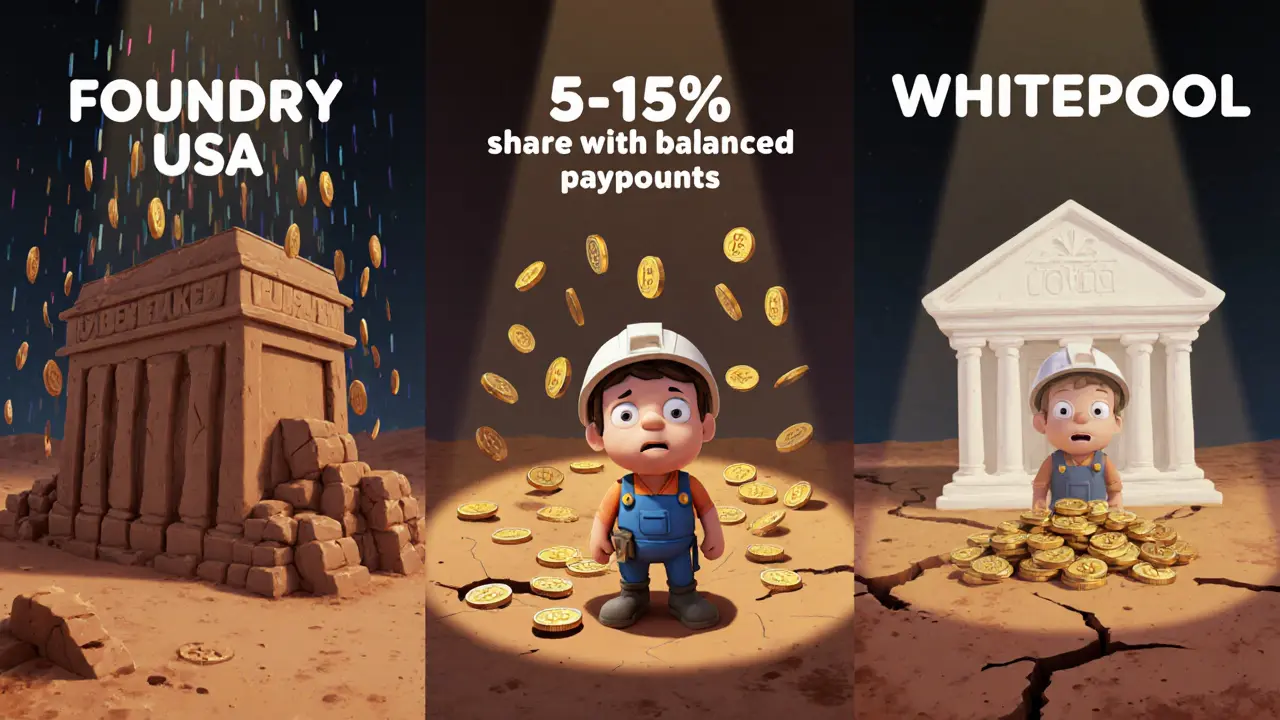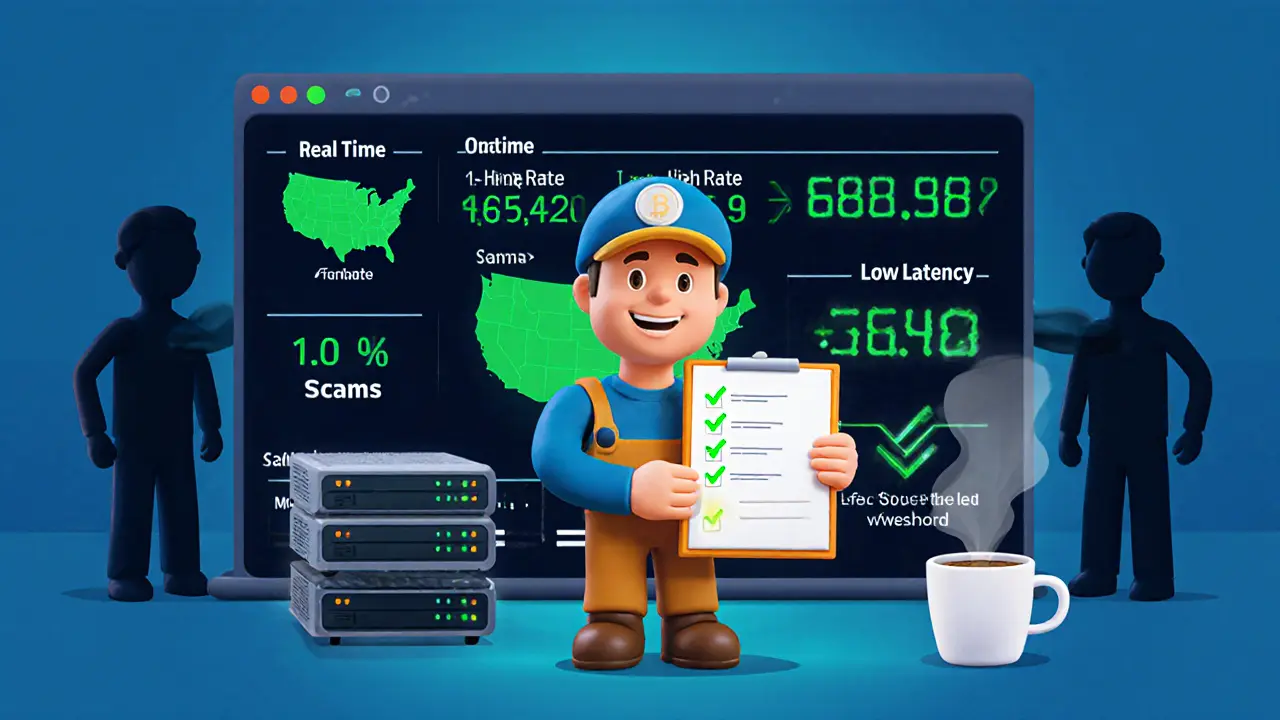How to Choose the Best Mining Pool for Maximum Crypto Profits
 Mar, 14 2025
Mar, 14 2025
Mining Pool Profit Calculator
Your Mining Setup
Network Conditions
Recommended Pools
Note: Recommendations based on your inputs. Check pool uptime and reputation before committing.
Choosing the wrong mining pool can cost you hundreds-or even thousands-of dollars a year. It’s not just about picking the one with the lowest fee. You need to understand how payouts work, where the servers are, how stable they are, and whether the pool actually pays on time. This isn’t theory. It’s real money. If you’re mining Bitcoin, Ethereum, or any other proof-of-work coin, your pool choice directly controls how much you take home.
Why Mining Pools Even Exist
Solo mining today is practically impossible for most people. The Bitcoin network’s hash rate is over 800 EH/s. That’s 800 quintillion calculations per second. Your home ASIC? Maybe 100 TH/s. That’s 0.0000125% of the total network. Without pooling your power with others, you might wait years to find a single block. Mining pools fix that by combining thousands of miners’ hash power. When the pool finds a block, rewards are split based on how much work each miner contributed.
You don’t need to be a tech expert to join. But you do need to know what you’re signing up for. A bad pool can drain your profits through hidden fees, downtime, or delayed payouts. A good one makes mining feel effortless.
Pool Fees: The Only Thing You Can Control
Every mining pool takes a cut. Most charge between 1% and 2%. Some go as high as 3% or even 4%. On the surface, that seems small. But if you’re earning 0.5 BTC a month, a 1% fee means $50 in fees at $100,000/BTC. A 3% fee? That’s $150 gone. That’s your grocery money.
But here’s the trap: the lowest fee isn’t always the best. Some pools with 0.5% fees don’t include transaction fees in payouts. Others charge extra for withdrawals. Some deduct fees for stale shares-shares you submitted too late to count. You have to read the fine print.
For example:
- Binance Pool charges 0.99% and includes transaction fees.
- Foundry USA charges 1.5% but has the highest hash rate and most consistent payouts.
- WhitePool charges 2% and has a history of delayed payments during market dips.
Don’t just pick the cheapest. Pick the one that gives you the most actual coins in your wallet.
Payout Methods: Steady Income vs. High Risk, High Reward
There are three main ways pools pay you. Each changes your cash flow dramatically.
- PPS+ (Pay Per Share Plus): You get paid for every valid share you submit, even if the pool doesn’t find a block. Transaction fees are included. This gives you steady, predictable income. Great for beginners or anyone who needs reliable cash flow.
- PPLNS (Pay Per Last N Shares): You only get paid when the pool finds a block. Your reward depends on how many shares you submitted in the last N shares before the block was found. This can mean huge payouts when the pool hits a block-or nothing for days. Best for miners who can handle volatility and have enough savings to wait.
- FPPS (Full Pay Per Share): Similar to PPS+, but includes both block rewards and transaction fees. Fees are higher (usually 1.8-2.5%) because the pool is guaranteeing you more.
Most experienced miners use PPS+ or FPPS. Why? Because they know how hard it is to budget when your income swings from $0 to $2,000 in a single day. If you’re mining with a small rig or just starting out, PPS+ is the only sane choice.
Hash Rate and Pool Size: Bigger Isn’t Always Better
As of late 2025, the top three Bitcoin mining pools control over 60% of the network:
- Foundry USA: 256.3 EH/s (26.6% market share)
- AntPool: 178.4 EH/s (17.96% market share)
- ViaBTC: 113.7 EH/s (13.69% market share)
Large pools find blocks more often. Foundry USA finds a block every 12-18 hours on average. That means you get paid daily. Small pools might go days or even weeks without finding a block. If you’re using PPLNS, that’s a long time with no income.
But here’s the twist: large pools mean smaller individual payouts. If you’re mining with a 100 TH/s rig and the pool has 200 EH/s, your share is tiny. On a smaller pool, your 100 TH/s might be 5% of the total. When they find a block, you get 5% of the reward-much bigger than your 0.05% share on a giant pool.
So what’s the sweet spot? For most home miners, aim for a pool with 5-15% market share. You get frequent payouts without your share being crushed.

Uptime and Server Location Matter More Than You Think
Every second your miner is disconnected is money lost. If your pool’s server goes down for 10 minutes during a high-difficulty window, you could miss out on 5-10 shares. Over a month, that adds up.
Top pools maintain 99.5%+ uptime. Check their status pages. Look for historical data. If a pool doesn’t publish uptime stats, that’s a red flag.
Server location is just as important. If you’re in Boulder and your pool’s only server is in Singapore, your connection latency is 180-220ms. That’s too high. You’ll submit stale shares-shares that arrive after the block has already been solved. Most pools consider shares stale if they’re over 100ms late. That means you’re getting paid for less work than you’re actually doing.
Choose a pool with servers in North America or Europe if you’re in the U.S. Foundry USA, F2Pool, and Luxor all have U.S.-based nodes. Avoid pools that only list servers in Asia unless you’re willing to lose 10-15% of your potential earnings.
Transparency and Reputation: Don’t Trust Anyone
There are scams in mining pools. Not many, but enough to ruin your year. Some pools manipulate share counts. Others delay payouts for months, hoping you’ll give up. Others shut down without warning.
Here’s how to avoid them:
- Check if the pool shows real-time dashboards with your hash rate, shares submitted, and estimated earnings.
- Look for public block find history. Can you see every block they’ve found in the last 30 days?
- Search Reddit, Bitcointalk, and Twitter for recent complaints. Look for patterns: “Still waiting for my payout since July,” “Pool stopped paying after the halving,” “No response to support tickets.”
- Verify their payment history. Use blockchain explorers to check if their wallet addresses have been consistently sending out payments.
Reputable pools like Foundry USA, F2Pool, and Binance Pool have been around for years. They have thousands of users and public blockchain records. If you can’t find any trace of a pool’s history, walk away.
User Experience: The Quiet Killer
Most guides ignore this. But if your dashboard is a mess, or the mobile app crashes every time you open it, you’ll stop checking your earnings. And if you stop checking, you won’t notice when something goes wrong.
Good mining pools offer:
- A clean, mobile-friendly dashboard
- Real-time notifications for pool downtime or payout issues
- Simple setup-no need to edit config files
- Clear documentation for your ASIC model
For example, Binance Pool lets you connect your Antminer S21 with just three clicks. Foundry USA requires manual config files. If you’re new, Binance wins. If you’re advanced and want full control, Foundry gives you more options.

What to Avoid
Here are the most common mistakes miners make:
- Choosing based on fee alone - You’ll lose more to downtime and stale shares than you save.
- Switching pools too often - Changing pools every week kills your consistency. Wait at least 30 days to evaluate.
- Ignoring withdrawal fees - Some pools charge $1-$5 per withdrawal. If you’re withdrawing small amounts daily, those fees eat your profit.
- Using pools with no U.S. servers - Latency will cost you 10-20% of your earnings.
- Trusting anonymous pools - If you can’t find who runs it, don’t mine there.
Final Checklist: Your 5-Minute Pool Selection Guide
Before you hit “Start Mining,” run through this:
- Fees: Is it under 1.8%? Does it include transaction fees?
- Payout method: Are you using PPS+ or FPPS? Avoid PPLNS unless you’re comfortable with volatility.
- Hash rate: Is the pool between 5-15% of the network? Avoid the top 2 unless you’re mining at scale.
- Server location: Are there servers in North America or Europe?
- Uptime: Do they publish 99%+ uptime stats?
- Reputation: Search “pool name + scam” or “pool name + delayed payout.” Any red flags?
- Dashboard: Can you see your earnings in real time? Is the mobile app reliable?
- Minimum payout: Is it under 0.002 BTC? Lower is better for small miners.
If you answered yes to all eight, you’re ready. If not, keep looking.
What’s Next?
Don’t set it and forget it. Mining changes fast. Every 4 years, Bitcoin’s block reward halves. New ASICs come out. Pools merge or shut down. Check your pool every 3-6 months. If your earnings drop and you can’t explain why, it’s time to switch.
Start with one of the top 5 pools. Test for 30 days. Track your earnings. Then compare. The right pool doesn’t just pay you-it makes mining feel like a job that actually works.
What’s the best mining pool for beginners?
For beginners, Binance Pool is the easiest. It has a simple dashboard, low fees (0.99%), includes transaction fees, and offers PPS+ payouts. You can connect your ASIC with minimal setup, and the mobile app works reliably. No need to understand complex terms-just plug in and start.
Is it better to use a large or small mining pool?
It depends on your goals. Large pools (like Foundry USA) pay daily, which is great for steady income. Small pools (under 5% market share) pay less often but give you larger shares when they find a block. If you’re mining with a single ASIC and want consistent cash flow, go large. If you’re mining with multiple rigs and can wait for bigger payouts, a mid-sized pool (5-15%) gives you the best balance.
Can I mine on multiple pools at once?
Yes, but only if you have multiple miners. You can’t split one ASIC between two pools. Each rig must connect to one pool at a time. Some miners rotate their rigs between pools every few days to test performance. But running the same rig on two pools simultaneously isn’t possible and will cause errors.
Why do I get stale shares?
Stale shares happen when your miner submits a solution after the block has already been found. This is usually caused by high latency-your rig is too far from the pool’s server. If you’re in the U.S. and connected to a server in Asia, your connection delay might be 200ms. Most pools reject shares over 100ms. Switch to a pool with servers closer to you to reduce stale shares by 50% or more.
Do mining pools ever steal my coins?
No reputable pool steals coins. They don’t need to-they earn through fees. But some shady pools delay payments indefinitely or shut down without warning. Always choose pools with a long track record and public blockchain payment history. If a pool can’t show you past payouts on-chain, don’t trust it.
How often should I switch mining pools?
Don’t switch more than once every 30-60 days. It takes time to see if a pool is truly profitable. Give it at least one full mining cycle-usually 3-4 weeks. If your earnings drop, check for server issues, fee changes, or increased network difficulty before switching. Frequent switching wastes time and increases the risk of downtime.
Vijay Kumar
November 26, 2025 AT 15:43Let me tell you something - if you’re still using PPLNS and thinking it’s ‘for the real miners,’ you’re just masochistic with your cash flow. PPS+ is the only way to not sleep like a nervous hedgehog.
Christina Oneviane
November 26, 2025 AT 22:13Oh wow, so the solution to mining profits is… reading? Who knew? I thought you just plugged in your ASIC and magic Bitcoin fairy dust fell from the sky. Thanks for the enlightenment, Captain Obvious.
Shelley Fischer
November 27, 2025 AT 03:43It is imperative to underscore the significance of server proximity in minimizing stale shares. Latency exceeding 100 milliseconds constitutes a non-trivial efficiency loss, particularly when operating under PPS+ or FPPS payout models. Furthermore, the omission of transaction fee inclusion in certain pools represents an implicit reduction in net yield, which, when compounded over time, may substantially erode profitability. Vigilance in selecting a pool with transparent, verifiable payout histories is not merely prudent-it is financially non-negotiable.